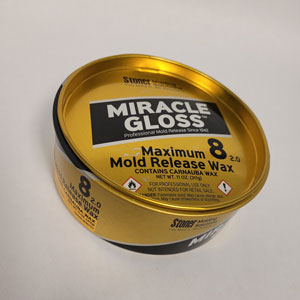When creating parts from molds—or even molds themselves—applying a release agent is an important step in the process. Mold release agents serve two basic purposes:
- Mold releases act as a parting agent between layers of resin and the mold surface, so that cured parts can be removed without damaging the part or the mold.
- When applied properly, mold releases help create a durable, high-gloss surface finish for finished parts.
Mold Releases help to preserve the integrity of your part and avoid damage to both the part and mold. The effort required to apply a quality release agent during preparation far outweighs the hours spent correcting damage later.
Click on an image below for more detailed product information and pricing.
-
This oil-based modeling clay is non-drying and can be carved and shaped easily without cracking. It features...
-
This oil-based modeling clay is non-drying and can be carved and shaped easily without cracking. It features...
-
Stoner's Miracle Gloss ® is a complete production mold system based upon proper mold preparation and a ...
The waxes in this category should be wiped on using a soft, clean towel. For the best results, liquid release agents, including PVA and FibRelease®, should be sprayed on using an appropriate tool, like our Preval Sprayer.
To better understand the importance of maintaining a Class-A surface finish for your mold, visit our Learning Center and read the white paper, Plug Surface Preparation and Mold Surface Maintenance.
Composite mold releases are substances applied to the surfaces of molds to prevent the adhesion or sticking of composite materials during the molding or casting process. These mold releases create a barrier between the mold surface and the composite material, allowing for easy release and separation once the part has cured or solidified. Here are some important aspects and characteristics of composite mold releases:
- Release Agents: Composite mold releases are often referred to as release agents or mold release agents. They are typically formulated as liquid or semi-liquid substances that can be sprayed, brushed, or wiped onto the mold surface or as a wax that can be applied in multiple layers by allowing the wax to harden before buffing off the access.
- Barrier Formation: The primary function of a composite mold release is to create a thin, non-stick barrier between the mold and the composite material. This barrier prevents the adhesion of the composite material to the mold surface, allowing for easy demolding and reducing the risk of part damage or mold distortion.
- Types of Mold Releases: There are various types of composite mold releases available, including wax-based releases, silicone-based releases, PTFE (polytetrafluoroethylene) releases, and water-based releases. Each type has its own characteristics, advantages, and recommended applications.
- Application Method: Composite mold releases can be applied using different methods, depending on the specific product and the size and complexity of the mold. Common application methods include spraying, brushing, wiping, or dipping the mold into the release agent solution.
- Mold Compatibility: It is important to select a mold release that is compatible with the specific mold material, such as fiberglass, epoxy, polyester, or silicone. Some mold releases may not be suitable for certain mold materials, as they could cause surface damage or interfere with the curing process of the composite material.
- Release Durability: The durability of a composite mold release refers to its ability to provide effective release properties for multiple molding cycles. Some mold releases offer multiple releases per application, while others may require reapplication after each cycle.
- Post-Mold Treatment: After demolding, it is common to clean the mold surface to remove any residual mold release agent. This step helps prepare the mold for subsequent moldings and ensures optimal part quality.
- Safety Considerations: When working with composite mold releases, it is important to follow the instructions for safe handling, storage, and application. Some release agents may contain volatile or hazardous components, so appropriate safety precautions, such as using personal protective equipment, should be taken.
Proper selection and application of a suitable composite mold release are essential for achieving good part quality and maintaining the mold's longevity. Consulting the guidelines and recommendations for the specific mold release product and composite material being used is crucial to ensure successful and trouble-free molding operations.
You can place your order on our website or, if you have any questions, call 1.800.838.8984 | 8 a.m. - 5 p.m. EST Mon-Fri.



